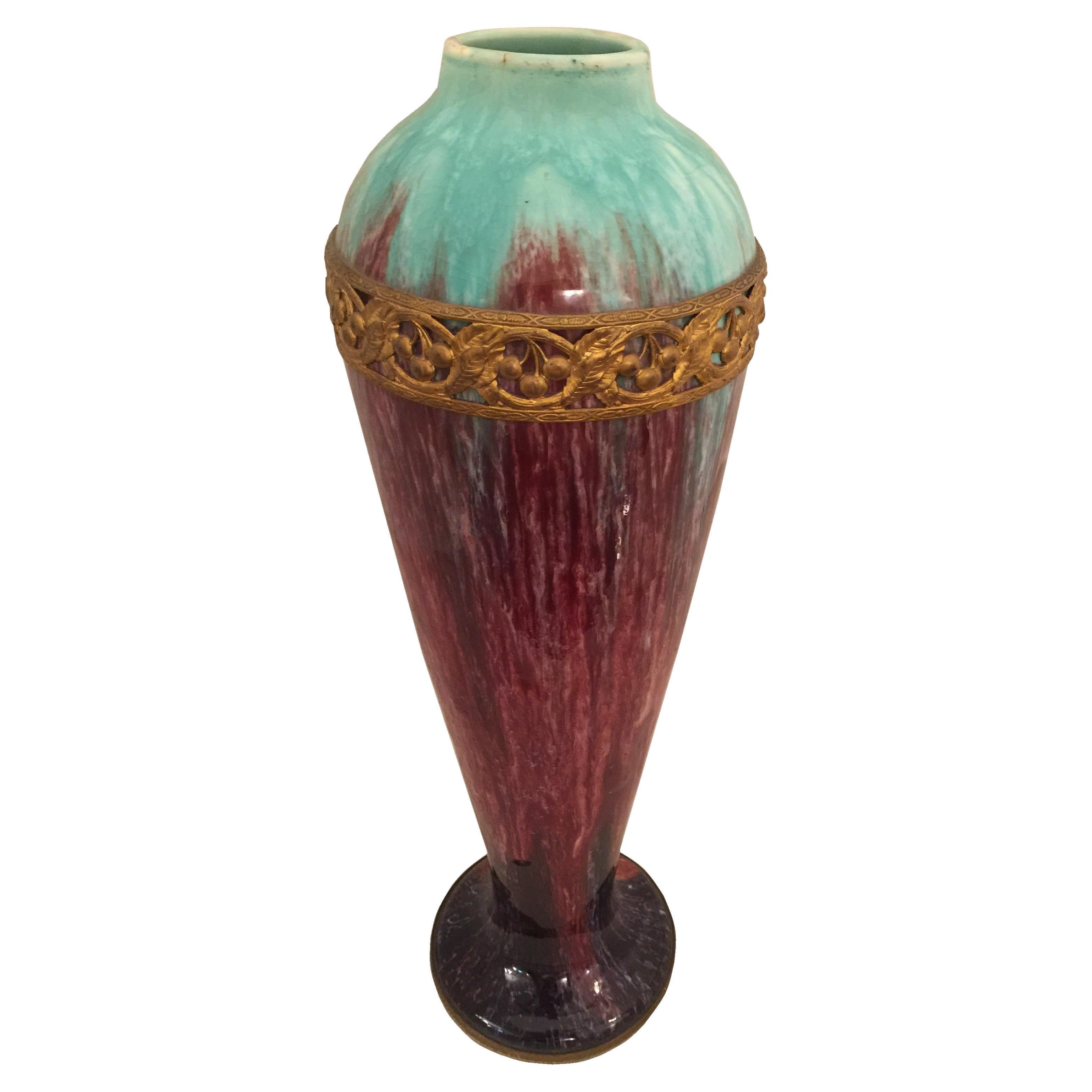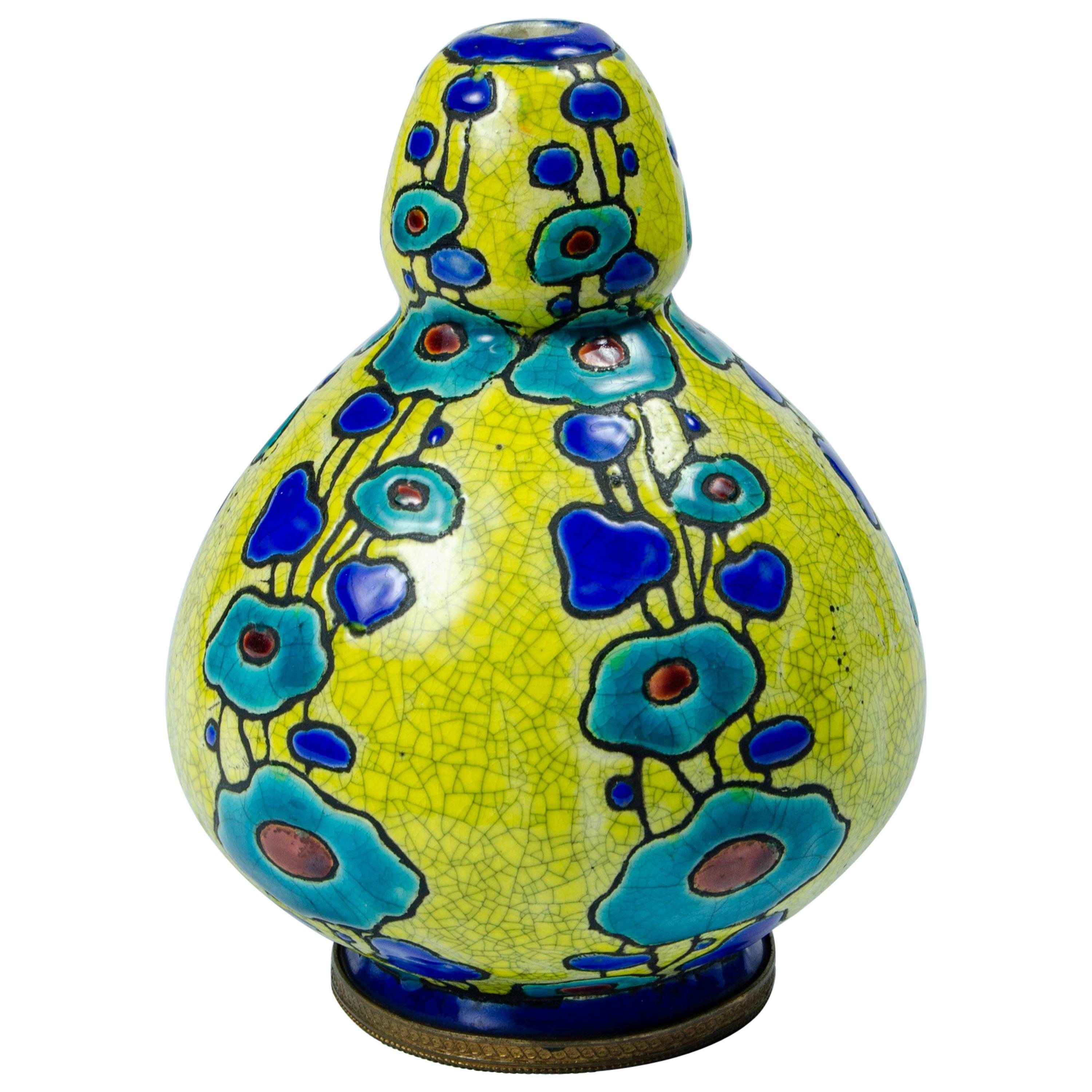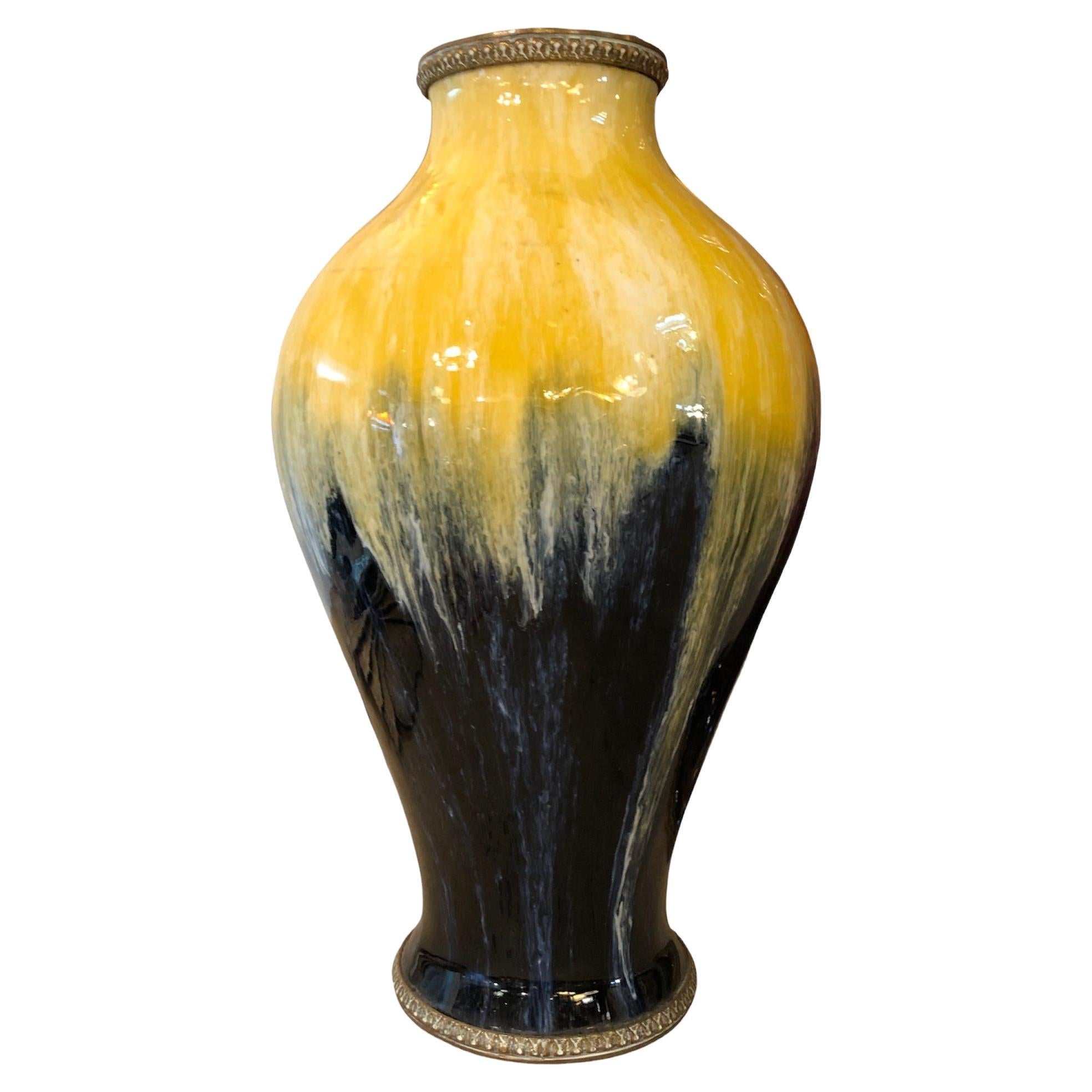Items Similar to Pair of Ceramics, Boch.F, Sign: Catherine Barjansky, Belgium
Video Loading
Want more images or videos?
Request additional images or videos from the seller
1 of 22
Pair of Ceramics, Boch.F, Sign: Catherine Barjansky, Belgium
About the Item
Pair of ceramics
Sign:
Ceramic with enamel : Catherine Barjansky
Made in Belgica Boch
Ceramic White:
Sign: BFK made in Belgium
The Boch manufacture was established in Belgian La Louvière by Jean-François Boch, one of main owners of another known company, Villeroy & Boch. The direction of Boch Freres SNC was in 1844 taken by Victor Boch. Production could be started immediately thanks to other Boch family ceramic businesses that sold Victor ready-to-use copperplates.
This faience manufacture developed very fast. In 1847 the company won a gold medal at the exhibition of the Belgian industry. In 1855 they already employeed 300 workers in La Louvière (Keramis) and 100 in Tournai (Boch Freres) factory. Around 1860 the production of polychrome pieces was started. In 1904 the first in Europe tunnel kiln was launched.
Problems started in 1970s. The company went bankrupt in 1985 and was reactivated as Novoboch and MRL Boch. In 2015 was started Keramis Center, just two rooms showing Royal Boch history.
One of the most important designers for Boch Frères Keramis was Charles Catteau. He was French but in 1906 moved to La Louvière. Patterns designed by Catteau were created in following years:
The Boch Frères Kéramis factory (Belgium, province of Hainaut, La Louvière) is now well known thanks to the work of the very dynamic Charles Catteau. That of the sculptor Catherine Barjansky is much less so, even if her career is international: Rome, Berlin, New York, Vienna, Paris, Brussels...
Catherine is from Odessa, a Ukrainian city located in the Soviet Empire. At the age of twenty, she studied sculpture in Monaco where she met her husband, Alexandre Barjansky, the famous violinist whose name is now inseparable from a Stradivarius! Thanks to her husband's job, she travels a lot.
Witnesses to his exchanges with the intellectual milieu of the time, his portraits of personalities dominate his work: a bust of Einstein, kept at the Solvay Institute in Brussels; a bust of Freud; or even Colette, author who prefaced her first exhibition in Brussels. She made a bust of Queen Elisabeth of Belgium, to whom she is close. Catherine Barjansky loved making “miniatures” and it was in a suitcase that she brought seventy of her works to Brussels for the first time to exhibit them there.
This art of sculpture - her passion - she exercised it throughout her life. She taught it in Rome where she founded a school in 1918, but also in Brussels in the 1920s and 30s and in New York after 1939.
Contacts with Charles Catteau and the Boch (BFK) company, located barely seventy kilometers from the capital, began around 1935. Hainaut coal was then a hotbed of creativity and a significant concentration of skills in fields of fire arts. Belgian Art Deco ceramics were living their hours of glory.
We have specialized in the sale of Art Deco and Art Nouveau and Vintage styles since 1982. If you have any questions we are at your disposal.
Pushing the button that reads 'View All From Seller'. And you can see more objects to the style for sale.
Why are there so many antiques in Argentina?
In the 1880 – 1940 there was a grate wave of immigration encouraged by the periods of war that were taking place.
1st World War took place between 1914 and 1918
2nd World War took place between 1939 and 1945
The immigrants options were New York or Buenos Aires. Tickets were cheap and in Buenos Aires they were welcomed with open arms, as it was a country where everything was still to be done.
Argentina was the country of new opportunities, labour was needed and religious freedom was assured, in many cases the of the family travel first until they were settled and then the rest of the family members join them.
In the immigrant museum “Ellis Island Immigrant Building” in New York you can se the promotional posters of the boats that would take them to a new life.
Between the years 1895 and 1896, Argentina had the highest DGP (gross domestic product) per capita in the world according to the Maddison Historical Statistics index, this situation arose due to the large amount of food being exported to European countries, which were at war.
The Argentinean ships left the port of Buenos Aires with food, but they returned with furniture, clothes and construction elements, (it´s common to see this the old buildings of the historic neighbourhood of San Telmo, the beams with the inscription “Made in England)”, as well as many markets that were built in Buenos Aires, such us the San Telmo Market, whose structure was brought by ship and afterwards assembled in 900 Defensa Street.
With the great influence of European immigrants living in the country, the children of the upper classes travelled to study in France, resulting in the inauguration of “La Maison Argentinienne”, on 27th of June 1928, in the international city of Paris, which hosted many Argentinians that were studying in Frace.
It´s the fourth house to be built after France, Canada and Belgium, being the first Spanish-speaking one. Still in place today (17 Bd Jourdan, 75014, Paris, France). Many of the children of these wealthy families who attended international art exhibitions, museums and art courses abroad, took a keen interest in the European style. This is why Buenos Aires was at the time referred as “The Paris of South America”.
Between the years 1890 and 1920 more than a hundred Palaces were built on Alvear Avenue the most exclusive avenue in Buenos Aires. Today some of these palaces have been transformed into museums, hotels and embassies.
In the year 1936, the Kavanagh building was inaugurated, it was the tallest reinforced concrete building in South America.
During 1994 the American Society of Civil Engineers distinguished it as an “international engineering milestone”, and it´s now considered a World Heritage of Modern Architecture.
At the time was common to hire foreign architects such as Le Corbusier, who visited Buenos Aires/Argentina in 1929 and in 1948 he drew up the blueprints for a house built in La Plata City (which was declared a World Heritage Site).
In 1947, the Hungarian architect Marcelo Breuer designed “Parador Ariston” in the seaside city of Mar del Plata. After an Argentinean student at Harvard University convinced him to come to Argentina. He worked on an urban development project in the Casa Amarilla, area of La Boca.
The Ukrainian architect, Vladimiro Acosta, arrives in Argentina in 1928 and worked as an architect until que moved to Brazil.
Antonio Bonet, a Spanish architect who worked with Le Corbusier in Paris, arrives in Argentina in 1937, where he carried out several architectural works and in 1938 designs the well-known BFK chair.
Andres Kálnay, of Hungarian origin, made around 120 architectural masterpieces, among which the former Munich brewery stands out, he even made the furniture’s design.
The German architect, Walter Gropius, director of the Bauhaus, lived in Argentina, where he wrote articles for “Sur” magazine and founded in Buenos Aires, an architectural firm with Franz Möller, who was also an architect, where he built two houses.
At the same time several famous designers decided to immigrate to Argentina, among them we can find the well-known French designer, Jean-Michel Frank, who arrived in the country in 1940 and also worked for the Rockefeller family.
Special pieces were made, which were sold exclusively in the country, such as the well-known German company “WMF”, who sold their products by catalogue, which were chosen by the ladies of high society in the list of wedding gifts, as well as the pieces designed by Christofle.
The Swiss sculptor Alberto Giacometti, made special pieces for Argentinean mansions.
In 1904 the first Jansen branch outside Paris was established in Buenos Aires, as the Argentinean clientele demanded a large amount of furniture, from the end of the 19th century to the mid-20th century.
In 1970, the brand Rigolleau Argentina made pieces authorised by Lalique.
The brands Maple and Thompson also set up shop in the country.
The French plastic artist, Marcel Duchamp moved to Argentina in 1918-1919.
Glass signed Gallé, Charder, Leverre, Schneider, Muller and other French firms. They were bought in flower shops and were given to ladies with beautiful floral arrangements.
Some furniture manufacturers travelled to international fairs and bough the patterns to produce the furniture in Argentina, such as the furniture firm Englander and Bonta, who bought the patterns ins Italy.
It is worth mentioning that in Argentina we have the largest community of Italians outside of Italy, as it is estimated that 70 percent of the inhabitants have at least one Italian descendant, followed by Spanish immigrants.
The most Important furniture stores in Argentina:
Comte is founded in 1934 (under the direct management of Jean Michel Frank in 1940).
Nordiska (Swedish company established in 1934).
Churba in 1960, a company that brought foreign designers to present their furniture in the country:
Denmark: (Arne Jacobsen, Finn Juhl, Bender Madsen, Ejner Larsen, Poul Kjaerholm, Hans Wegner)
Sweden: (Hans Agne Jakobsson, Gustavsberg)
United States: (Herman Miller)
Finland: (Lisa Johansson, Folke Arstrom, Tapio Wirkkala, Alvar Aalto, Timo Sarpaneva)
Swedish Factory: (Orrefors)
Italy: (Littala, Vico Magistretti, Emma Gismondi, Gae Aulenti, Angelo Mangiarotti, Elio Martinelli, Gianna Celada, Angelo Mangiarotti, Mario Bellini, Carlo Scarpa)
Finland: (Olivia Toikka)
Plata Lappas (Lappas Silver): a goldsmith shop founded in 1887 in Argentina by Alcibiades Lappas of Greek origin.
In 2019, in Argentina took place “the Art Deco world congress”, in which we participated as hosts invited by Geo Darder, founder of the Copperbridge – Foundation, in which prominent people from all over the world attended to learn about Art Deco in Argentina.
Argentina currently has more than 100 Art Deco buildings and another 90 Art Nouveau buildings throughout the city of Buenos Aires.
Argentina is a country that has not been involved in many wars, which is why it has been a refuge for works of art and antiques from different periods of time, unlike European countries. That is way many collectors, museums and antique dealers from all over the world visit it, you should not miss the opportunity to visit this great country.
Laura Guevara Kjuder, architect.
- Dimensions:Height: 18.51 in (47 cm)Width: 11.82 in (30 cm)Depth: 3.94 in (10 cm)
- Style:Art Deco (Of the Period)
- Materials and Techniques:
- Place of Origin:
- Period:
- Date of Manufacture:1935
- Condition:Wear consistent with age and use.
- Seller Location:Ciudad Autónoma Buenos Aires, AR
- Reference Number:
About the Seller
5.0
Vetted Seller
These experienced sellers undergo a comprehensive evaluation by our team of in-house experts.
Established in 1982
1stDibs seller since 2022
21 sales on 1stDibs
Typical response time: <1 hour
- ShippingRetrieving quote...Ships From: Ciudad Autónoma Buenos Aires, Argentina
- Return PolicyThis item cannot be returned.
More From This SellerView All
- Ceramic Sign: Boch Belgium, French BronzeLocated in Ciudad Autónoma Buenos Aires, CCeramic: Sign: Boch Belgium, French ironwork The Boch manufacture was established in Belgian La Louvière by Jean-François Boch, one of main owners of another known company, Villeroy...Category
Vintage 1920s Belgian Art Deco Centerpieces
MaterialsBronze
- Ceramic Sign: Made in Belgium, Boch F. La louviere Fabrication BelgeBy Boch La LouviereLocated in Ciudad Autónoma Buenos Aires, CCeramic: Sign: Made in Belgium, Boch F. La louviere Fabrication Belge The Boch manufacture was established in Belgian La Louvière by Jean-François Boch, one of main owners of another...Category
Vintage 1920s Belgian Art Deco Centerpieces
MaterialsBronze
- Pair of Ceramics, Sign: Czechoslovakia, Hand PaintedLocated in Ciudad Autónoma Buenos Aires, CCeramic We have specialized in the sale of Art Deco and Art Nouveau and Vintage styles since 1982. If you have any questions we are at your disposal. Pushing the button that reads ...Category
Vintage 1920s Czech Art Deco Centerpieces
MaterialsCeramic
- Ceramic Sign: Boch F. La louviere Fabrication Belge, Made in Belgium 898By Boch La LouviereLocated in Ciudad Autónoma Buenos Aires, CSign: Boch F. La louviere Fabrication Belge, Made in Belgium 898 The Boch manufacture was established in Belgian La Louvière by Jean-François Boch, one of main owners of another know...Category
Vintage 1920s Belgian Art Deco Centerpieces
MaterialsBronze
- Ceramic, Boch Belgium, French BronzeLocated in Ciudad Autónoma Buenos Aires, CCeramic: Boch Belgium, Sign: 869, French ironwork The Boch manufacture was established in Belgian La Louvière by Jean-François Boch, one of main owners of another known company, Vil...Category
Vintage 1920s Belgian Mid-Century Modern Centerpieces
MaterialsBronze
- Pair of Ceramics, German, 1920Located in Ciudad Autónoma Buenos Aires, CPair of ceramics We have specialized in the sale of Art Deco and Art Nouveau and Vintage styles since 1982. If you have any questions we are at your disposal. Pushing the button ...Category
Vintage 1920s German Art Deco Ceramics
MaterialsCeramic
You May Also Like
- Charles catteau ceramics BochBy Charles CatteauLocated in Buenos Aires, ArgentinaArt Deco glass ceramic manufactured Boch Design Charles Catteau French Belgian origin perfect condition.Category
Vintage 1920s French Art Deco Ceramics
MaterialsCeramic
- Bunch of Grapes, Ceramics by Hans Hedberg, Biot, FranceBy Hans HedbergLocated in Stockholm, SELarge bunch of grapes made by Hans Hedberg (1917-2007) Swedish ceramist who had his studio in Biot, near nice in France. Hedberg worked with several fam...Category
Vintage 1960s French Scandinavian Modern Ceramics
MaterialsCeramic
- Pair of Early French Terracotta Figures of Pomona and a Girl, Signed ClodionBy Claude Michel ClodionLocated in New York, NYA fantastic pair of 18th/19th century French terracotta figures of Pomona and a Girl Carrying Fruit in her Skirt, Signed Clodion. These excep...Category
Antique 1790s French Rococo Busts
MaterialsTerracotta
- Handmade Sassi Ceramics by Le MeduseLocated in Geneve, CHHandmade Sassi ceramics by Le Meduse Unique pieces Dimensions: W 25, D 15, H 18 cm Materials: Glazed ceramics bicolor. Each model is unique because it is handmade, it can be re...Category
2010s Italian Post-Modern Abstract Sculptures
MaterialsOther
- Harmfull Ceramics Sculpture by Alina RotzingerLocated in Geneve, CHHarmfull ceramics sculpture by Alina Rotzinger Dimensions: H 35 x W 30 x D 20 cm. Materials: high temperature ceramics, oxide pigments and dead flowers. Composed by Alina Rotzin...Category
2010s Spanish Post-Modern Abstract Sculptures
MaterialsOther
- Pair of Signed Ceramic Fish Sculpture by Mexican Artist Sergio BustamanteLocated in Los Angeles, CAA lovely pair of signed ceramic fish by Mexican artist Sergio Bustamante. The captivating blue and green body of this fish is dappled with light and comes to an expressive fin an...Category
20th Century Ceramics
MaterialsCeramic
Recently Viewed
View AllMore Ways To Browse
Silver Miniature Boat
Hans Muller Bust
Hans Wegner Queen
Stradivarius Vintage
Giacometti Sculptures Pair
Giacometti Bust
Mazel Jalix
Mermaid Door Knocker
Miffy Silver
Mina Beresford
Neptune And Salacia Lamps
Olympus Guardian Hermes
Oskar Lindenberg
Pair Of Murano Glass And Sterling Silver By Vittorio Angini
Pal Kepenyes On Sale
Par Geo Maxim
Reproof Marble
Robert Kuo Grapes





